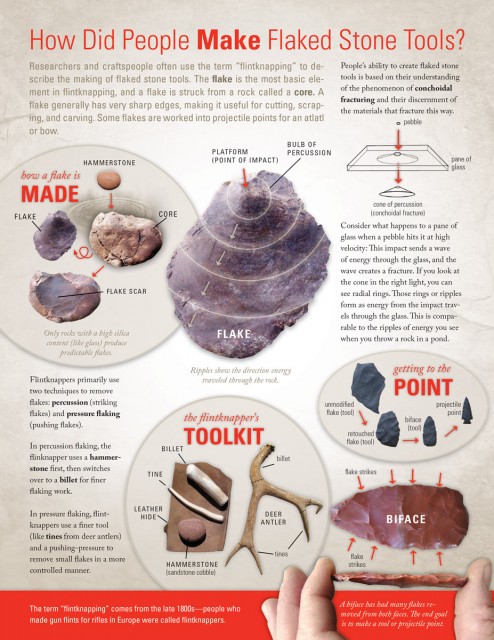
Researchers and craftspeople often use the term “flintknapping” to describe the making of flaked stone tools. The flake is the most basic element in flintknapping, and a flake is struck from a rock called a core. A flake generally has very sharp edges, making it useful for cutting, scraping, and carving. Some flakes are worked into projectile points for an atlatl or bow.
Flintknappers primarily use two techniques to remove flakes: percussion (striking flakes) and pressure flaking (pushing flakes).
In percussion flaking, the flinknapper uses a hammerstone first, then switches over to a billet for finer flaking work.
In pressure flaking, flintknappers use a finer tool (like tines from deer antlers) and a pushing-pressure to remove small flakes in a more controlled manner.
People’s ability to create flaked stone tools is based on their understanding of the phenomenon of conchoidal fracturing and their discernment of the materials that fracture this way.
Consider what happens to a pane of glass when a pebble hits it at high velocity: This impact sends a wave of energy through the glass, and the wave creates a fracture. If you look at the cone in the right light, you can see radial rings. Those rings or ripples form as energy from the impact travels through the glass. This is comparable to the ripples of energy you see when you throw a rock in a pond.
How did people use foreshafts?
People hafted projectile points and arrowheads onto short, tapered pieces of wood known as foreshafts. The foreshaft, in turn, socketed into the front end of the arrow shaft or atlatl dart. When shot, the foreshaft pierced the animal and—the hunter hoped—the dart fell away, to be retrieved and reused. Archaeologists have found preserved foreshafts in rock shelters and caves. In openair sites, the wood elements rot away.
What do archaeologists learn from stone tools, other than how people made them?
- Traditions and change through time—For archaeologists, projectile points are very important artifacts. People of the same cultural tradition made the same styles of points, but over time, those styles changed. Controlled excavation has enabled archaeologists to date these points. So, when we find one, we can fairly accurately tell what group the toolmaker was a part of and when the point was made—in other words, who lived at a place and when.
- Trade/exchange—toolmakers understood what kinds of stone flaked well, and people often widely traded good tool stone in the past. Chemical and mineralogical sourcing methods enable archaeologists to determine where a tool stone originated, which may be a considerable distance from where they find evidence of its use, as manufacturing debris or as finished or broken tools. Assessing these patterns helps archaeologists reconstruct ancient trade and travel routes.
- Activities—People made different kinds of tools for cutting and scraping. By studying the flakes and tools people left behind, archaeologists are able to describe what kinds of tool-based activities people were undertaking.
Want to learn more? Explore the major concepts, places, cultures, and themes that Southwestern archaeologists are investigating today in our Introduction to Southwestern Archaeology.